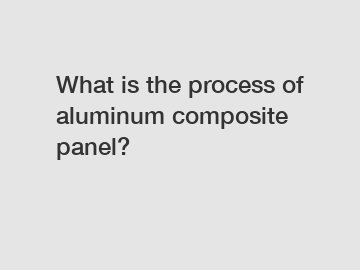What is the process of aluminum composite panel?
LITONG supply professional and honest service.
What is the Process of Aluminum Composite Panel?
Aluminum composite panels (ACP) have become increasingly popular in construction and architectural applications due to their durability, versatility, and aesthetic appeal. The process of manufacturing these panels involves several steps that ensure their high quality and performance. In this article, we will delve into the intricacies of the aluminum composite panel production process, exploring the materials used, the manufacturing techniques employed, and the various applications of ACPs.

1. Raw Materials for Aluminum Composite Panels:
The production of aluminum composite panels begins with the selection of high-quality materials. The primary components consist of two aluminum sheets bonded to a non-aluminum core. The aluminum sheets provide strength, weather resistance, and a sleek finish, while the core material, commonly made of polyethylene (PE) or mineral-filled fire-retardant (FR) compounds, contributes to the panel's rigidity and fire-resistant properties.
2. Pre-treatment and Coating Application:
Before the aluminum sheets are joined with the core material, they undergo pre-treatment processes to ensure optimal surface preparation. These processes include degreasing, etching, and chemical conversion coating, which enhance adhesion and corrosion resistance. After pre-treatment, a coating is applied to the aluminum sheets to enhance their visual appeal and protection against environmental factors.
3. Bonding Aluminum Sheets with the Core:
Once the pre-treatment and coating processes are complete, the aluminum sheets are bonded to the core material using a specialized adhesive. This adhesive is carefully selected to ensure a strong and durable bond between the sheets and the core. The adhesive layer maintains the integrity of the panel by providing a secure connection, while allowing flexibility to accommodate thermal expansion and contraction.
4. Panel Formation and Shaping:
After bonding the aluminum sheets with the core, the composite sandwich is passed through a pair of shaping rollers that apply pressure evenly to the entire panel surface. This step ensures uniform thickness and flatness. Subsequently, the panels can be further shaped according to specific design requirements, such as folding or curving, through advanced CNC routing and bending machines.
5. Surface Finishing:
ACP manufacturers offer various surface finishes to cater to different aesthetic preferences and architectural styles. These finishes can include glossy, matte, brushed, or patterned coatings. The desired finish is achieved using specialized rolls, which impart the desired texture or pattern onto the panels' surface.
6. Cutting and Fabrication:
Once the panels are manufactured and coated, they undergo cutting and fabrication processes. Computerized cutting equipment allows precise dimensions and shapes to be achieved, ensuring perfect alignment during installation. These panels can be cut into various sizes to suit different construction needs, making them highly versatile.
7. Applications of Aluminum Composite Panels:
Aluminum composite panels find extensive use in both residential and commercial applications. Their lightweight nature, ease of installation, and flexibility make them an ideal choice for external cladding, interior decoration, signage, and more. Additionally, ACP's exceptional durability and fire-resistant properties make them suitable for high-rise buildings, corporate offices, airports, stadiums, and other public structures.
8. Environmental Considerations:
In an era where sustainability is crucial, the use of aluminum composite panels offers several environmental benefits. The panels are fully recyclable, contributing to reducing waste and conserving natural resources. Furthermore, ACPs are energy-efficient, helping to reduce heating and cooling costs when used as insulation.
In conclusion, the process of manufacturing aluminum composite panels involves carefully selecting and bonding aluminum sheets with a core material, shaping and finishing the panels, and applying surface coatings. These panels find wide-ranging applications in the construction and architecture industry due to their durability, versatility, and environmental advantages. With constant advancements in production techniques and material innovations, the popularity and usage of aluminum composite panels are likely to continue growing in the coming years.
Please visit our website for more information on this topic.
Want more information on aluminium coated coil factory? Feel free to contact us.



